It doesn’t take an avid traveller to know about the Swiss Alps. As one of the most famous mountain ranges in the world, it’s still a common misconception that the Alps only exist in Switzerland. The Alps are the highest and most prominent mountain range in Europe but they actually extend through eight countries. Quite impressive, right? Each country is home to a slightly different variation of the Alps but they are all equally as magnificent.
While many are aware that the Alps also exist in France and Italy, the mountains in Germany and the Deutsche Alpenstrasse remain overlooked. Before we experienced the German Alpine Road for ourselves, we never even heard of it!
In this guide, we’ll dive into an excellent touring route known as the Deutsche Alpenstrasse, which goes through the Bavarian Alps of Germany.
JUMP TO
- Essentials for Driving the Deutsche Alpenstrasse
- What and Where Is the Deutsche Alpenstrasse?
- Getting to the German Alpine Road
- Is Driving the Deutsche Alpenstrasse Worth It?
- How to Experience the Deutsche Alpenstraße
- Bavarian Alps Road Trip Map
- The Deutsche Alpenstrasse Route: Best Places to See
- Practical Information About the Deutsche Alpenstrasse
- Where to Stay During Your Alpenstrasse Road Trip
- Travel Resources for Exploring the Deutsche Alpenstrasse

Essentials for Driving the Deutsche Alpenstrasse
✈️ If you’re flying internationally, the best place to fly into for the Deutsche Alpenstrasse is Munich. Flights to Munich are often cheaper because it’s such a major airline hub.
🚗 People who are renting a car should do so in Munich. This allows you to begin and end your road trip in Munich, therefore completing an efficient loop.
🚠 A recommended 4 – 7 days should be allocated to a road trip of the Deutsche Alpenstrasse. Otherwise, it’ll feel too rushed and you won’t be able to experience any of the landmarks like cable car rides to mountain peaks.
🥾 The Deutsche Alpenstrasse is an ideal road trip for anyone who enjoys mountainous landscapes, the great outdoors, and history.
👍 While it is one of the best driving roads in Europe, the German Alpine Road is not difficult to navigate, even by an inexperienced traveler.
What and Where Is the Deutsche Alpenstrasse?
The Deutsche Alpenstrasse is a scenic route which runs through the southern part of Germany (Bavaria) and its Alps region. It is most frequented by bicyclists, campers, touring clubs and really anyone who enjoys driving over the Alps. First mention of this iconic Alpine road dates back to the mid 1800s by the King of Bavaria (at the time) named Maximillian II. Fast forward to today and it’s arguably one of the best driving roads in Europe.
The German Alpine road is greatly underrated in comparison to other famous Alps driving routes but equally as tremendous. The Deutsche Alpenstrasse is located in Germany but runs along the border with Austria and Italy. Geographically and technically speaking, the Alpenstrasse route begins in Lindau which is a town situated on Lake Constance, also known as Bodensee. From this Bavarian town, the Alpine route stretches east and ends in Königssee which is over 400 km away.
Of course, there are no official rules on how to experience the Deutsche Alpenstrasse or any road trip for that matter. If you wish to complete the tour in reverse or only have time to finish half of it, that’s OK too! The German Alpine Road provides endless panoramic views, beautiful landmarks and mountain peaks throughout its entirety. Having a strict Alps itinerary or route to follow isn’t absolutely necessary.
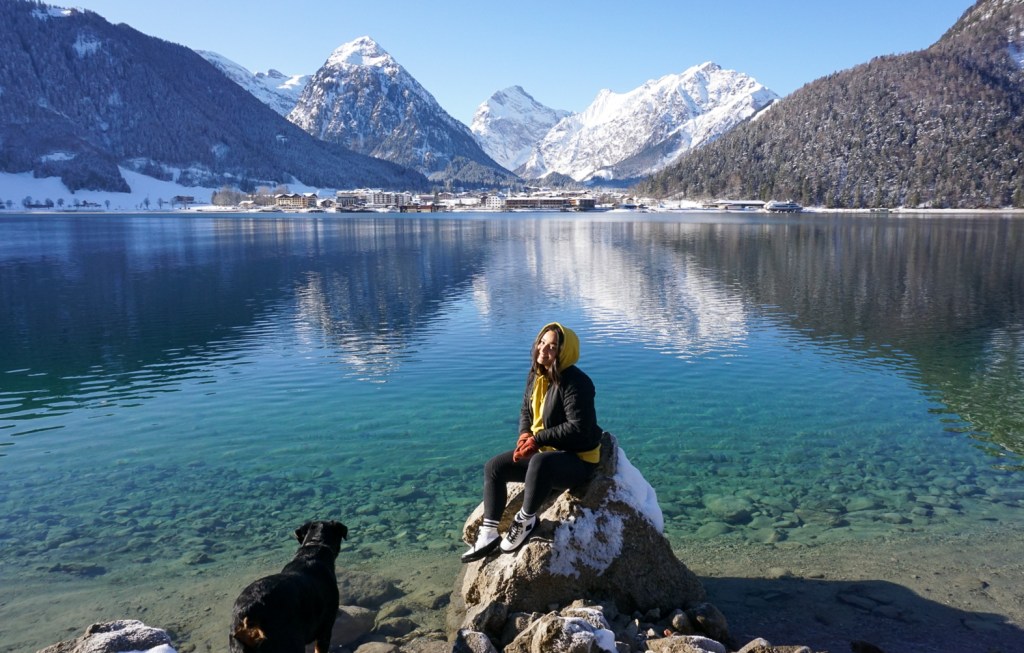
Getting to the German Alpine Road
By Flying
Catching a flight to Bavaria and renting a car in order to experience the Deutsche Alpenstrasse is a feasible option. There are a couple of options for anyone looking to fly into the area. Whether you are starting in Lindau or Königssee, there are possibilities for flying into the nearest airport closest to either city.
In Lindau, there is technically a minor international airport named Bodensee Airport Friedrichshafe. However, flights lack variety and often only served between Bodensee and Frankfurt. In terms of convenience, the two easiest major airports to fly into if you plan on starting in Lindau are Zurich or Munich.
If you plan on starting in Königssee, flying into Salzburg Airport is the nearest option. However, since you’ll likely be renting a car, you’ll want to make a loop which is why flying into Munich is the best option for getting to the German Alpine Road.
The best overall option: By flying into and starting your road trip from Munich, you can either drive towards the direction of Lindau or Königssee, complete the Alps route and head back to Munich. A loop as a route trip route is always the most ideal scenario!
Train
If you don’t prefer driving from Munich to either starting point on the Deutsche Alpenstrasse, taking a train either west or east is another sensible option.
From Munich, it’s possible to take a train to Lindau. The most direct train route will take under 3 hours with one transfer in Hergatz station before reaching Lindau-Insel.
On the opposing side, a train route between Munich and Berchtesgaden Hauptbahnhof also exists. Berchtesgaden Hauptbahnhof is the nearest train station to Schönau am Königssee, less than ten minutes away. The journey between Munich and Königssee also takes under 3 hours and has one transfer at Freilassing station.
Is Driving the Deutsche Alpenstrasse Worth It?
There are many reasons to opt for a Bavarian Alps road trip opposed to one in Switzerland or even the Dolomites in Italy. One of the biggest advantages of exploring the German Alpine Road is simply because it’s lesser know to international travellers. Since it’s somewhat flying under the radar in comparison to other popular Alps roads, it means attractions are less crowded and accommodation is cheaper. In general, nearly everything will cost a bit less since the Bavarian Alps are not as touristy.
The most significant reason anyone should visit the Deutsche Alpenstrasse is for its natural beauty. Mountain peaks, rolling hills, luscious valleys and stunning lakes are just some of the wonders of Germany’s Alps. The area also holds a lot of history and is home to many remarkable landmarks from castles to WWII bunkers.

How to Experience the Deutsche Alpenstraße
Driving (Your Own Car)
There is nothing quite like driving through the Alps and the the Deutsche Alpenstraße is no exception. If you are looking to experience the German Alpine Road, it should be by driving it. Depending on when you visit, you also do not need an over capable vehicle to do so. As long as it’s not during a heavy snowfall, a Bavarian Alps road trip can be accomplished with just about any car. It does not matter how small it is or if it doesn’t have AWD/4WD. In fact, smaller cars will have a more enjoyable time on the many twists and turns that make up the Alpine road.
This is the case with all road trips, but you’ll want to have the ability to make many stops, detours and spur-of-the-moment decisions, which can only be done by driving. One of the best ways to enjoy the Deutsche Alpenstrasse is by allowing it to take you wherever your interests peak and not only by following an itinerary.
With a Rental Car
It can seem intimidating at first, but experiencing a road trip in Europe is incredibly easy for anyone, even if you don’t have your own car. You do not have to reside in Europe in order to enjoy its countless scenic touring routes. Whether you’re already starting in Germany or another country in Europe, renting a car and driving to the Deutsche Alpenstrasse is uncomplicated, even for a beginner traveller.
The most cost effective rental car is found in Munich, especially if you are starting and ending your journey there. Whenever planning a road trip with a rental car, just be mindful of your pickup and drop off location and whether it correlates to your road trip route. It’s important to remember that renting a car in one place and returning it in a different place is much more expensive.
With a Guided Tour
If driving the Deutsche Alpenstrasse is not in the cards for you, there are still ways to enjoy the best of the Alps. Many tours operate and depart from major cities such as Salzburg or Munich and visit the top sites in the Bavarian Alps. This is a great alternative to those short on time or not interested in driving themselves.
Booking a guided experience or tour with included transportation is also ideal for anyone not looking to plan their own itinerary. It’s a huge time saver to simply book a tour and have everything planned out for you!
Bavarian Alps Road Trip Map
The Deutsche Alpenstrasse Route: Best Places to See
Although the Deutsche Alpenstrasse is a route in Germany, it easily overlaps with nearby attractions in Austria and even Italy. Below are our recommendations on highlights to see along the German Alpine Road in addition to a couple of stops in neighbouring areas. Depending on what you are most interested in seeing and how accessible it is on your chosen route, we recommend branching outside of Germany during your road trip. Remember, there are no concrete rules!

1. Lindau and the Allgäu Region
It makes the most sense to begin a road trip in Lindau and travel east. If you are starting at Lake Constance (or Bodensee), you’ll enter the Allgäu region via Oberjoch Pass which is comprised of both foothills and impressive mountains. Along the twisted Oberjoch Pass are fantastic panoramic views such as the observation deck found here. The Allgäu area is also well known for its castles with Neuschwanstein Castle being the most famous.
On your route from Lindau, you can reach the renowned Neuschwanstein Castle in 1.5 hours but we recommend making stops along the way. Vilsalpsee is a serene lake tucked between peaks, a pasture land and forest greenery. It’s definitely one of the lesser known lakes in the Bavarian Alps and an incredible spot for a swim if you’re visiting in the summer.
Hohenschwangau Castle is Neuschwanstein Castle’s direct neighbor and equally as gorgeous of an attraction. If you have the time, a visit to both castles is warranted. To reach the Disney-like Neuschwanstein Castle, you must park below and walk up a paved road for 20-30 minutes. There is also a paid shuttle or hose carriage ride if you do not want to walk uphill.
Nearby, you’ll find something for adrenaline lovers – the Highline179 is a suspension bridge built over 400 meters up and above a gorge. It connects to the ruins of a Gothic era castle named Ehrenberg Castle, which is not preserved like Neuschwanstein but still a majestic site to see. Close to the suspension bridge sits another mesmerizing alpine lake, Heiterwanger See, which can be walked around in under two hours.
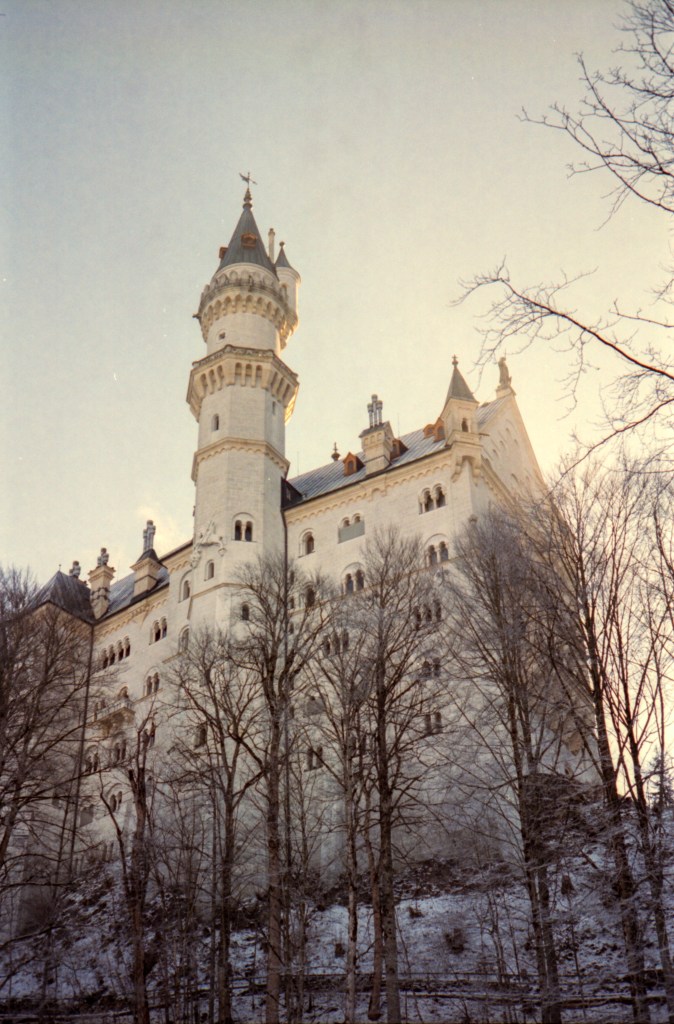
Optional Detour to Reschensee Lake
For those looking to see something spectacular, we highly recommended making a detour down south, through Austria and towards the Italian border. Reschensee is a lake located just 2.5 km from the Austrian border and in the South Tyrol region. Apart from the delightful little village, Reschen am See, Reschensee is home to one of the most interesting attractions we’ve ever seen. Campanile di Curon Venosta Vecchia (or Curon Bell Tower) is a church tower from the medieval era which sits partially submerged in the lake. If you visit during the winter, the lake is frozen over and it’s possible to walk to it or even ice skate around it.
Read More: Reschensee – A Hidden Gem of the Italian Alps



2. Zugspitze Peak & Eibsee
The Zugspitze is Germany’s tallest mountain and conveniently located along the Deutsch Alpenstrasse which makes it the perfect Alps road trip itinerary item. A brilliant and futuristic structure with panoramic views is built at the very top and accessible to anyone looking to visit the top of Germany.
The impressive Gletscherbahn cable car reaches the summit of Zugspitze in just minutes. Although not cheap, tickets that start around €50 (round trip) are still worth the price for the jaw dropping experience and view at the top.

At the base of Zugspitze, you’ll find the sensational lake of Eibsee. It doesn’t matter what time of year you visit as the scenery is simply beautiful year round. The lake is hugged by trees and features a clear-cut view of Zugspitze straight above. If you happen to visit in the winter, It’s quite the experience to enjoy a completely frozen lake with almost nobody else around.
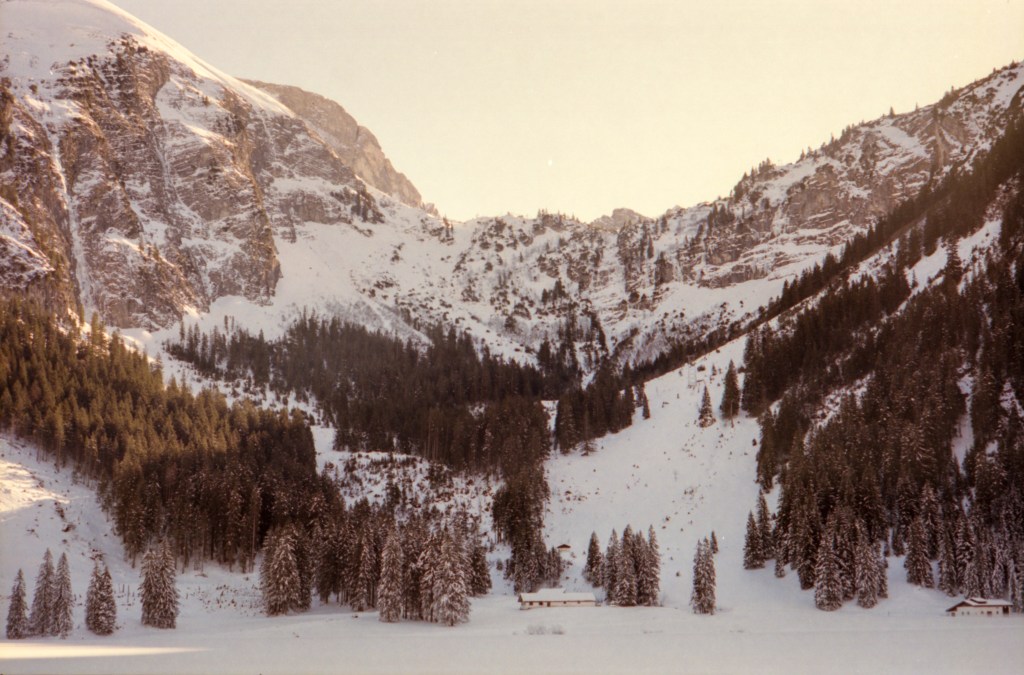
3. Partnachklamm
Just south of Garmisch-Partenkirchen is Partnach Gorge (also know as Partnachklamm). It’s a gripping natural wonder and definitely a must see item on any Bavarian Alps itinerary. The gorge is notably deep with a river cutting through it and accessible to anyone, based on how much of it you want to see.
Throughout Partnach Gorge, you’ll find silent pools of water, mountain streams and powerful waterfalls. Although it’s particularly popular with eager hikers, it is also possible to park and view it casually after a 20-30 minute walk from the designated parking lot here.
From the same trail which Partnachklamm is located on, you’ll find the historic cable car from the 1950s named Graseckseilbahn. When visiting the cable car, you can also utilize the Graseck’s private car park and skip the walk from Garmisch-Partenkirchen. The main purpose of the cable car is to reach Hotel Das Graseck which is a dreamy spa and hotel tucked away in the forest.
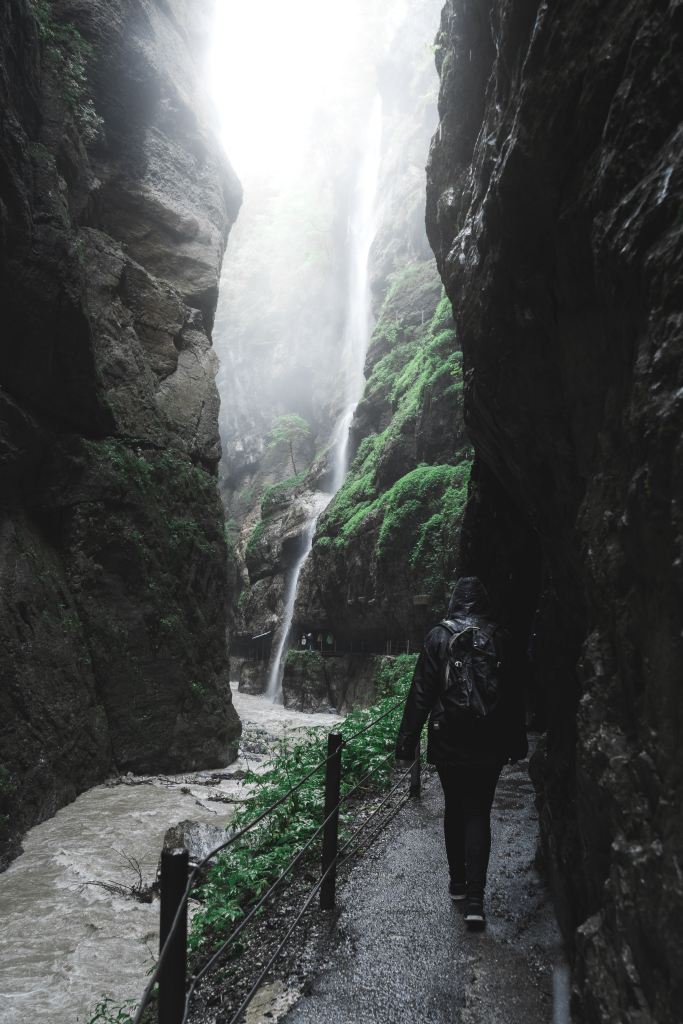
4. Oberammergau
The city of Oberammergau is a quintessential Bavarian town. With its pristinely clean streets, beautifully decorated buildings and endless bakeries or places to grab a beer stein, it’s one of the most recognisable towns along the Deutsch Alpenstraße. The charming town center of Oberammergau Zentrum is classically delightful and the perfect place for a stroll while checking out the many boutique shops and cafes.

5. Wagenbrüchsee
The petite lake of Wagenbrüchsee is a bit of a hidden gem along the Deutsch Alpenstrasse. Just above the lake, you’ll find the most picturesque viewpoint with Wagenbrüchsee below and surrounding mountains behind it. This one tranquil spot seems to sum up the entire atmosphere of Bavaria and the German Alpine Road. The location can be visited in the winter or summer, both lovely in their own way.
To reach this specific position, park your car near Gästehaus Gebirgsblick, but not on their private property. Make sure you are leaving your car on a public road. Then, walk up the slight hill and enter the scene of your very own private Bob Ross painting.

6. Walchensee
By taking Route 11 north, you will come across Wasserfall Obernachkanal, the perfect quaint spot for a road trip break. The tranquil waterfall is modest, unspoiled and a simple example of the purely natural wonders you’ll come across on the Deutsch Alpenstrasse. If you stop here in the summer, you’ll likely see the vibrant turqoise color of the waterfall’s pool below.
Route 11 continues on and directly along the waterfront of Walchensee lake. It is one of the most dominant alpine lakes in the Bavarian Alps and particularly popular in the summer for swimming and family vacations. The most enchanting viewpoint of Lake Walchen can be found here. The town of Walchensee is an excellent place to find lunch or hang out at a beer garden with an amazing view.
Whether you are coming down south or continuing to drive up north, Kesselberg Pass links the towns of Kochel and Lake Walchen. The twisty pass can be a whirlwind of a drive but does hold one particularly beautiful viewpoint here.


7. Karwendel Mountains and Mittenwald
On the border between Bavaria and Tyrol sits the Karwendel mountain range. Most of the mountain range belongs to Austria but there is a small northern section which is Bavarian. On the Passamani Rundweg hiking path, you can quite literally walk the border between the two countries after taking the cable car to the top of Karwendel.
Tourists are able to take advantage of Germany’s second highest cable car ride with prices cheaper than the reigning Zugspitze peak. Enjoy sweeping panoramic views while having lunch on the terrace, 2,244 metres up in the sky.
Karwendel’s cable car departs from Mittenwald, an endearing Bavarian town at the base of the mountain range. The old town (or Mittenwald Altstadt) of Mittenwald is straight out of a storybook and an exemplary Bavarian destination. Aside from being picture perfect, it’s very well located to many hiking areas.

8. Achensee
A short detour from the Deutsche Alpensee will take you to Achen Lake. Also known as Achensee, the lake is located just across the border and in Austria. Achensee is notably one of the most photogenic alpine lakes near the Bavarian Alps. It is without a doubt a must see item on any Alps road trip itinerary. It is possible to drive along Achensee on the eastern shoreline. The western side is reserved to be a pedestrian walking trail and great for anyone to enjoy since it’s flat.
You also easily access Achensee through the town of Pertisau. Pertisau has a lovely waterfront boardwalk with boat services available in the summer months. Achen Lake is primarily a summer hot spot with its numerous lake beaches and clear water. Arguably the best scenic viewpoint in Achensee with a back dorp of towering mountains can be found here.


9. Berchtesgaden National Park
Driving among the northern Bavarian Alps and through Sudelfeld pass will get you to possibly the best section of the Deutsch Alpenstrasse. This is why many visitors opt to travel from west to east as they like saving the best for last!
Berchtesgaden town and its surrounding area of Nationalpark Berchtesgaden are undoubtedly the scenic high points of the German Alpine Road and packed with many things to see and do. The Berchtesgaden Alps holds a lot of history, particularly surrounding WWII.
For fanatics of history, there is no shortage of attractions and landmarks to check out. From museums, to old bunkers and fortresses to the famous Eagle’s Nest, it’s enough for nearly everyone to find interesting. Kehlsteinhaus (known as the Eagle’s Nest) is the infamous grand retreat perched on a mountain top. It was historically used by Hitler and the Nazi party. It is open for visitors and something quite unique to see for yourself.
On the border of Germany and Austria is the famed Rossfeld Panorama Strasse (or Rossfeld-Panoramastraße) which likely holds the most breathtaking views on the Deutsch Alpenstrasse. The pass offers one panoramic vista after another and a handful of places to stop for a coffee or beer with an unforgettable view.


10. Königssee
To properly wrap up a road trip in the Bavarian Alps, a stop in Königssee and the lake is a must. From the town’s waterfront, you can take a boat to easily tour the lake. A boat ride will allow you to see the historic wooden boat houses and St. Bartholomew’s Church further down the lake.
The national forest of Malerwinkel surrounds Lake Königssee and is an easy hike for those looking to walk around the lake to catch sweeping views. One of the best viewpoints of Königssee and the boats floating by below can be found at Rabenwand.
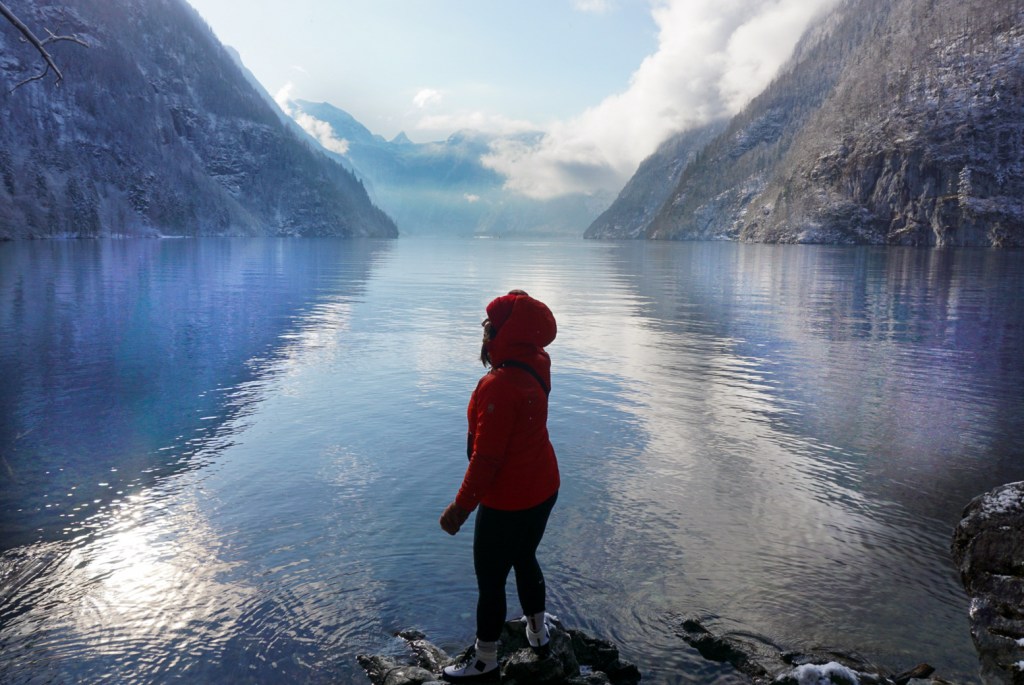

Practical Information About the Deutsche Alpenstrasse
Is Driving the German Alpine Road Difficult?
If you consider yourself an above average driver, driving through the Alps is not difficult. For a first timer who has never driven in Europe before, driving the Deutsche Alpenstrasse is probably not the best scenario to put yourself in. Common characteristics of the roads in the Alps are narrow streets, back to back hairpins and steep inclines or declines.
For an American, the most apparent thing that may shock you at first about Alps driving routes are the skinny roads. Not only are they tapered but they are also often shared with gigantic trucks. Once you’ve driven in Europe a couple of times, this becomes less and less surprising.
Our best advice for an Alps road trip or any road trip through an unknown area is to pair yourself with a really great co-pilot. A handy passenger will give you a heads up about directions and which way the roads will turn, thus allowing you to focus solely on driving safely.
Best Time to Road Trip The German Alpine Road
To make your road trip in the Alps as delightful as possible, aim to schedule your trip for late spring or early fall. April and October both have highs of around 15°C / 59°F which is comfortable enough to be outdoors without freezing. Driving the Deutsch Alpenstrasse in September is absolutely ideal. Temperatures are still warm and typically get to a high of 20°C / 68°F. Keep in mind, mountain weather is unpredictable and it will be impossible to avoid rain entirely.
Unless you are prepared to potentially drive in the snow, do not plan on driving throughout the Alps in winter. However, if you are like us, you may purposefully set out for just that reason, to experience the snow! As long as your expectations are set for a potentially more complicated drive, the winter time is a magnificent time to drive the Deutsche Alpenstraße.
Visiting the Deutsche Alpenstrasse during the summer time is also a good option for nice weather. However, it will be the most crowded as many families will take their holiday during this time. A road trip is often better with less cars on the same route as you.

How Many Days Should You Spend Exploring the Deutsche Alpenstraße?
Without any stops, the journey from Lindau to Königssee could be completed in one day. On paper, the drive is only four hours long. But at that point, this is no road trip and merely a commute! To properly experience the German Alpine Road, you should plan a 3-4 day itinerary at the least. Even with a few days, you likely won’t be able to cover everything the Deutsche Alpenstrasse has to offer. Still, you will be able to see its major highlights. European families will easily spend a couple weeks or longer in this area for their summer vacation.
If you are setting out on a road trip from Munich, you’ll need to factor in the travel time from Munich itself. Travel time is two hours between Lindau – Munich and Königssee – Munich.
Where to Stay During Your Alpenstrasse Road Trip
Mittenwald – 💕 Best for Couples
Bäckeralm B&B – Book with Booking.com or Agoda
Pension Bavaria – Book with Booking.com or Agoda
Gästehaus Sonnenheim – Book with Booking.com or Agoda
Oberammergau – 👨👩👧 Best for Families
Ferienhaus In den Bergen – Book with Booking.com
Hotel Wittelsbach Oberammergau – Book with Booking.com or Agoda
Zum Kirchenbauer – Book with Booking.com or Agoda
Berchtesgaden – 🍻 Best for Groups
Alpinhotel Berchtesgaden – Book with Booking.com or Agoda
Alpenhotel Denninglehen – Book with Booking.com or Agoda
Gästehaus Sonnenbichl – Book with Booking.com or Agoda
Travel Resources for Exploring the Deutsche Alpenstrasse
![]() TRAVEL INSURANCE: EKTA or VisitorsCoverage
TRAVEL INSURANCE: EKTA or VisitorsCoverage
![]() CAR RENTALS: Rentalcars.com or Discover Cars
CAR RENTALS: Rentalcars.com or Discover Cars
![]() ACCOMMODATION: Booking.com, Hostelworld or Trivago
ACCOMMODATION: Booking.com, Hostelworld or Trivago
![]() ESIM / CELL PHONE DATA: Airalo
ESIM / CELL PHONE DATA: Airalo
![]() TOURS & ACTIVITIES: GetYourGuide or Viator
TOURS & ACTIVITIES: GetYourGuide or Viator
Affiliate Disclaimer: Please note that some links found in our posts are affiliate links. Should you choose to purchase through these links, we may receive a small commission at no extra cost to you.
Pingback: Tips for Visiting Swizerland for the First Time - Adventures of Ace
Pingback: Netherlands Road Trip Route - Adventures of Ace
Pingback: Reschensee (Lago Di Resia): A Hidden Gem of the Italian Alps